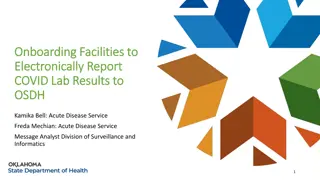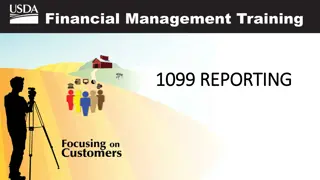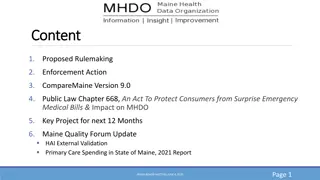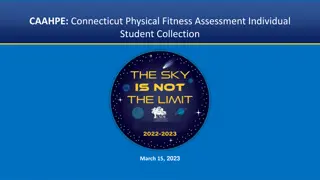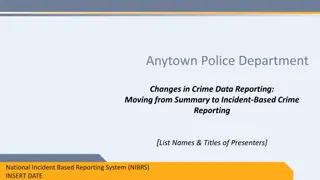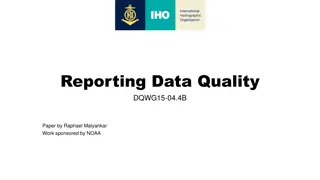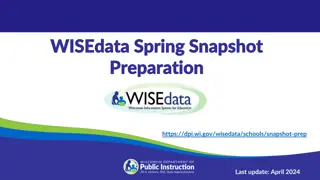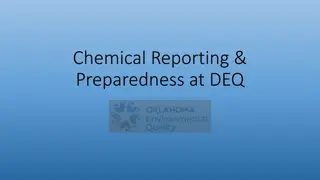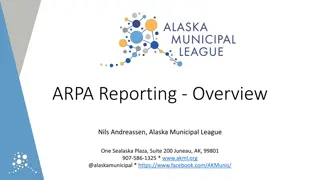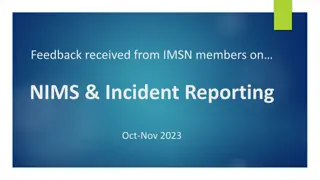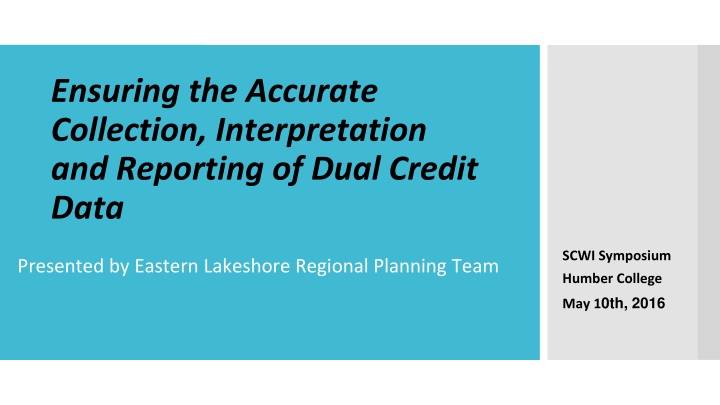
Enhancing Dual Credit Data Accuracy in Educational Symposium
Discover the importance of accurate data collection in the context of dual credit programs through insights shared at the SCWI Symposium by the Eastern Lakeshore Regional Planning Team. Explore the challenges, best practices, and the impact of reliable data on decision-making for student support and program development.
Download Presentation

Please find below an Image/Link to download the presentation.
The content on the website is provided AS IS for your information and personal use only. It may not be sold, licensed, or shared on other websites without obtaining consent from the author. If you encounter any issues during the download, it is possible that the publisher has removed the file from their server.
You are allowed to download the files provided on this website for personal or commercial use, subject to the condition that they are used lawfully. All files are the property of their respective owners.
The content on the website is provided AS IS for your information and personal use only. It may not be sold, licensed, or shared on other websites without obtaining consent from the author.
E N D
Presentation Transcript
Ensuring the Accurate Collection, Interpretation and Reporting of Dual Credit Data SCWI Symposium Presented by Eastern Lakeshore Regional Planning Team Humber College May 10th, 2016
Adriana McDonough Financial Services Coordinator, Durham College William Howe Manager, Dual Credit Operations, Fleming College Introductions in order of appearance! Sue Hawkins SCWI Administrative Coordinator, Durham College Karin Savage SCWI, Records and Registration, Durham College Stephen McBride Pathways Consultant, KPR District School Board and Co-Chair of ELRPT
Importance of Accurate Data Collection Models of Data Collection by the Eastern Lakeshore Regional Planning Team Over the Years Agenda Ongoing Issues Roundtable of Best Practices
Good data provides good rationales at proposal writing time. Enables sound (smart) decisions regarding proposals. Drives approvals! Importance of Accurate Data Collection Allows colleges and boards to advocate for increased supports, programming and/or funding for students in the primary target group. Enables Student Management Systems and ONSIS to be in sync. Provides positive feedback for your RPT and board and college partners (Admin councils, trustees, presidents, deans ).
Model 1 The handwritten form
Model 1 (cont d) The one-man show
# of entries Field CONTACT INFORMATION 7 WHAT GETS ENTERED? Program Success: up to 6 fields # OF STUDENTS WHO STARTED and FINISHED (by age and gender) PROFILE OF STUDENTS (by gender) 16 Up to 39 fields of data need to be entered 10 4 boards x 39 fields = 156 pieces of data. PROGRAM SUCCESS (including SWAC) 6 39 totals
BREAKDOWN OF ELRPT: 48 PROJECTS (many with multiple boards in each project) 5 SCHOOL BOARDS 3 COLLEGES 3,800 STUDENTS BACK TO MODEL 1 48 PROJECTS TRANSLATE TO: 194 individual dual credit reports 96 collated board reports 39 potential entries per board report 96 x 39 =
UP TO 3,744 PIECES OF STUDENT DATA TIME TO REVIEW MODEL 1 .
Missing information Inconsistencies Model 1 Key Issues and Concerns Errors/incorrect information
Model 2 The collaborative process www.earndualcredits.ca
Students register electronically through earndualcredits.ca All dual credit teacher forums now include information about data collection (importance, accuracy Formal meetings are now officially on the calendar (2 days per semester) where board and college partners examine the data together before entering information into EDCS Model 2 Process Board and college partners bring class lists to compare accuracy of data. In case of discrepancies, we defer to the college as their admissions records are very detailed.
Board coordinators are encouraged to in-service dual credit teachers, guidance, VPs about the characteristics of students in the primary target group Data collection forms are distributed to all dual credit teachers well in advance of the end of semester. Forms now contain specific information and direction for each of the data entry cells. All completed forms are submitted first to the Board coordinators to ensure they are completed accurately and in full Model 3
RPT6 Model of Data Collection Model 3 Adobe LiveCycle The electronic form that collates! https://kprecadobelive.kprdsb.ca:8443/workspace/Main.html?ap=1 %26startEndpoint=SCWI/Processes/SCWI%20Final%20Reporting%20 Form.Dual%20Credit%20Final%20Reporting%20Form
Model 4 The electronic registration form on earndualcredits.ca automatically populates a custom database Ongoing tweaks (Durham College)
Model 4 Ongoing tweaks (Durham College)
Subject Subject Catalog CULN CULN CULN CULN CULN CULN CULN CULN CULN CULN CULN CULN CULN CULN CULN CULN CULN CULN CULN CULN CULN Catalog Section 31 31 31 31 31 31 31 31 31 31 31 31 31 31 31 31 31 31 31 31 31 Section Name L03 L03 L03 L03 L03 L03 L03 L03 L03 L03 L03 L03 L03 L03 L03 L03 L03 L03 L03 L03 L03 Name Beausoleil,Brooke Ann Boos,Fiona Irene-Dianne Cavanagh,Kaitlin Teresa Cooligan,Kaitlyn Eileen Czarnik,Katya Margerat Gemmiti,Olivia Carolyn Jean Gibb,Maya Allegra Gibson,Addison Mary Gillis Bateman,Madison Mary Teresa Green,Nick James Hickie,Leah Keating,Chloe Teresa M Kilborn,Cassandra Jane Nora Moodie,Ryan Scott Winston Oettinger,Mallory Quinn Paschalis,Kristian Anthony Powers,Matthew Glen Proulx,Victoria Irene Rappos,Marrie Leah Shirley Sorichetti,Edie Ruth Stephen,Andrew Matthew Wilke-Whittington,Emma Mereka- Francisca Grade Grade Drop Dt Drop Dt 79 72 74 79 80 80 80 74 80 80 79 65 71 74 82 71 Group Group ST PETER ST PETER ST PETER ST PETER ST PETER ST PETER ST PETER ST PETER ST PETER ST PETER ST PETER ST PETER ST PETER ST PETER ST PETER ST PETER Seats Seats Start Start Finish Finish Credits Credits 23 21 21 21 Model 4 Ongoing tweaks (Fleming College) 18/09/2015ST PETER 74 79 74 82 ST PETER ST PETER ST PETER ST PETER CULN 31 L03 79 ST PETER Did not start W Fail
Project Project School School Subject Subject Catalog Catalog Section Section Group Group # Seats # Seats # Start # Start # Finish # Finish # Credits # Credits Avg Grade Avg Grade Success Rate Success Rate % > 70% % > 70% Retention Retention Seat % Seat % 602BUS CULN 31 L03 ST PETER 23 21 21 21 77 100% 95% 100% 91% 606SENR ECOS 13 L79 PORT PERRY 25 18 18 18 88 100% 100% 100% 72% 606SENR TOUR 39 L62 ST THOMAS 14 12 12 12 87 100% 100% 100% 86% 606SENR COMM 78 S60 ST THOMAS AQUINAS 16 12 12 7 86 58% 100% 100% 75% 607JCD SOCI 25 C15 ST PETERS&HOLY CROSS 15 18 18 16 61 89% 28% 100% 120% 608BUS CULN 31 L04 NORWOOD 15 19 15 15 73 100% 67% 79% 100% Model 4 610HW COSM 9 L50 HALIBURTON HIGHLANDS 18 17 14 14 83 100% 93% 82% 78% 610SENR TOUR 39 L63 HOLY TRINITY 20 7 6 6 74 100% 83% 86% 30% 640GAS MATH 18 S04 ST PETES 18 15 14 14 79 100% 86% 93% 78% 640GAS MATH 18 S03 COURTICE SS 14 14 14 14 82 100% 86% 100% 100% 640GAS MATH 130 S60 LCVI 20 23 20 18 67 90% 40% 87% 100% Ongoing tweaks (Fleming College) 640GAS MATH 130 S09 ST STEPHEN 24 14 14 14 67 100% 50% 100% 58% 652STT MECH 255 L06 ST PETER-X 22 20 20 20 75 100% 75% 100% 91% 652STT MECH 255 L04 COURTICE-X 22 22 21 21 74 100% 71% 95% 95% 652STT MECH 255 L05 ST STEPHENS-X 20 20 20 20 70 100% 65% 100% 100% 652STT CNST 161 L01 CLARKE HS 18 18 18 18 81 100% 94% 100% 100% 652STT CRPT 18 L03 CRESTWOOD 20 18 18 18 88 100% 100% 100% 90% 652STT CRPT 19 L01 CRESTWOOD 20 18 18 16 75 89% 83% 100% 90% 652STT MECH 201 L06 LCVI 20 17 12 12 85 100% 92% 71% 60% Total Total 733 733 666 666 593 593 566 566 77 77 96% 96% 77% 77% 88% 88% 81% 81%
The 10 day count! What does this mean? 10 days after registration? 10 days after the first college class? Ongoing Issues Business days, calendar days, hours? Once a week, twice a week, compressed? Late registrations? Do all colleges follow the same 10-day rule?
Counting the double tech credit? 20 students in a double period construction class: Do we count them as having earned 40 high school credits and 20 college? Or 20 and 20? Withdrawals: Let s clarify Ongoing Issues If a student withdraws before the 10 day count, they do not count as having started. If a student withdraws after the 10 days, they are counted as started but not finished . Approvals vs actuals are based on the 10 day count (number started) Retention and success are based on the numbers who finished the dual credit.
Over Enrollment: Do we count students that are over the approved number of seats? Ongoing Issues (continued) Ex: 15 seats are approved but 18 students were actually in the dual credit. Do we count the extra 3 students?
SHARING OF BEST PRACTICES: Roundtable Discussion of Best Practices
From ELRPT Thank you



